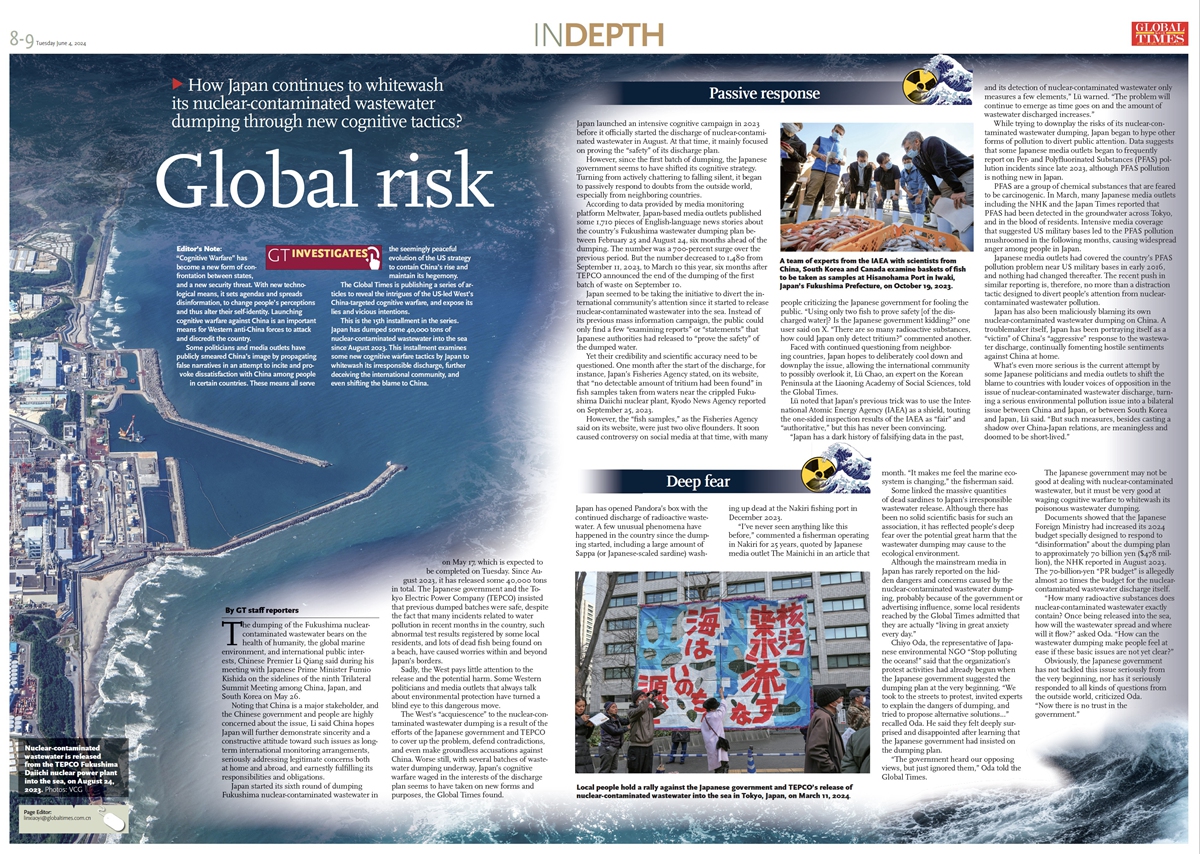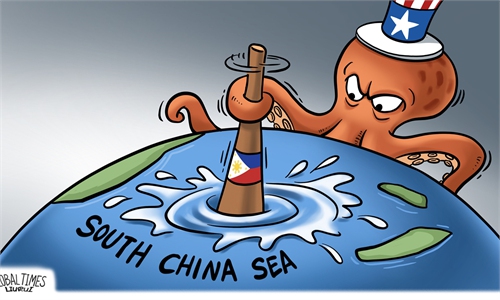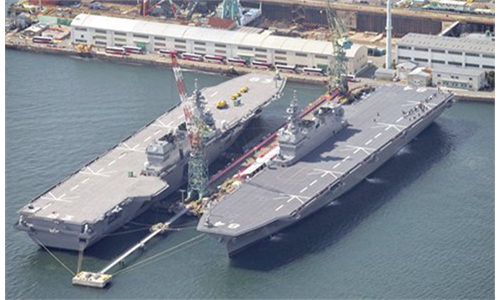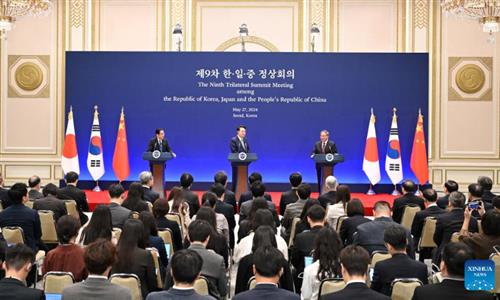IN-DEPTH / IN-DEPTH
GT investigates: How Japan continues to whitewash its nuclear-contaminated wastewater dumping through new cognitive tactics?
Global risk
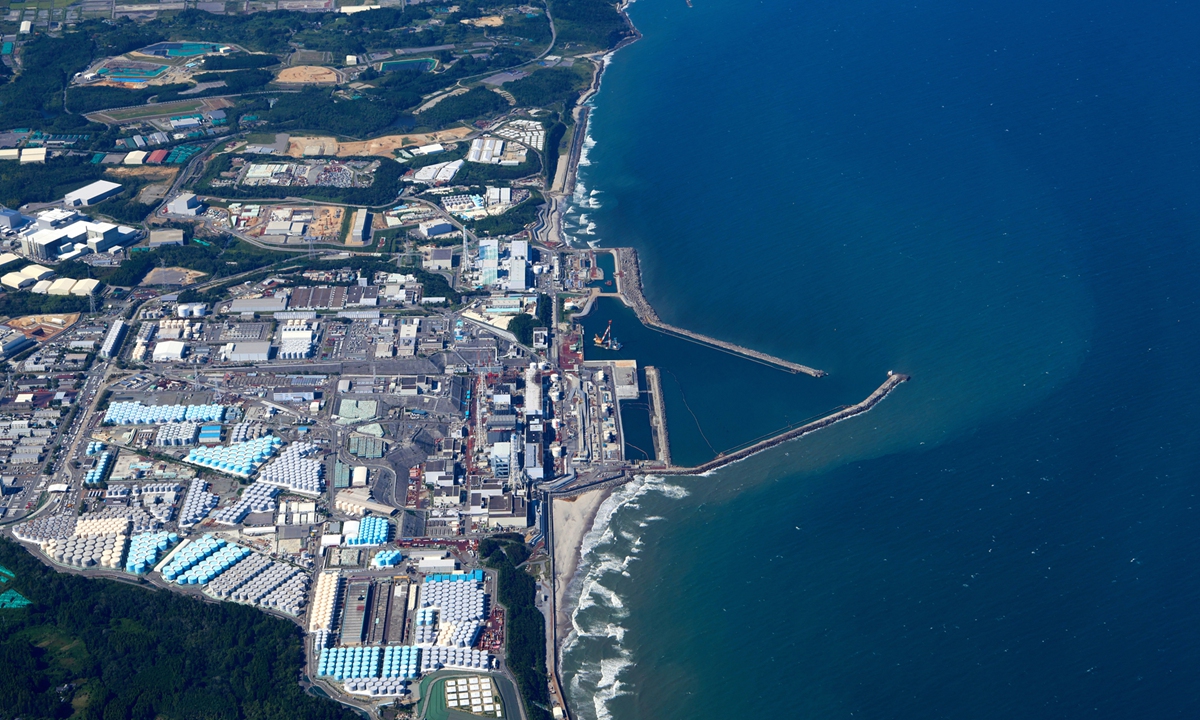
Nuclear-contaminated wastewater is released from the TEPCO Fukushima Daiichi nuclear power plant into the ocean on August 24, 2023. Photo: VCG
Editor's Note:
"Cognitive Warfare" has become a new form of confrontation between states, and a new security threat. With new technological means, it sets agendas and spreads disinformation, to change people's perceptions and thus alter their self-identity. Launching cognitive warfare against China is an important means for Western anti-China forces to attack and discredit the country.
Some politicians and media outlets have publicly smeared China's image by propagating false narratives in an attempt to incite and provoke dissatisfaction with China among people in certain countries. These means all serve the seemingly peaceful evolution of the US strategy to contain China's rise and maintain its hegemony.
The Global Times is publishing a series of articles to reveal the intrigues of the US-led West's China-targeted cognitive warfare, and expose its lies and vicious intentions.
This is the 15th installment in the series. Japan has dumped some 40,000 tons of nuclear-contaminated wastewater into the sea since August 2023. This installment examines some new cognitive warfare tactics by Japan to whitewash its irresponsible discharge, further deceiving the international community, and even shifting the blame to China.
The dumping of the Fukushima nuclear-contaminated wastewater bears on the health of humanity, the global marine environment, and international public interests, Chinese Premier Li Qiang said during his meeting with Japanese Prime Minister Fumio Kishida on the sidelines of the ninth Trilateral Summit Meeting among China, Japan, and South Korea on May 26.
Noting that China is a major stakeholder, and the Chinese government and people are highly concerned about the issue, Li said China hopes Japan will further demonstrate sincerity and a constructive attitude toward such issues as long-term international monitoring arrangements, seriously addressing legitimate concerns both at home and abroad, and earnestly fulfilling its responsibilities and obligations.
Japan started its sixth round of dumping Fukushima nuclear-contaminated wastewater in on May 17, which is expected to be completed on Tuesday. Since August 2023, it has released some 40,000 tons in total. The Japanese government and the Tokyo Electric Power Company (TEPCO) insisted that previous dumped batches were safe, despite the fact that many incidents related to water pollution in recent months in the country, such abnormal test results registered by some local residents, and lots of dead fish being found on a beach, have caused worries within and beyond Japan's borders.
Sadly, the West pays little attention to the release and the potential harm. Some Western politicians and media outlets that always talk about environmental protection have turned a blind eye to this dangerous move.
The West's "acquiescence" to the nuclear-contaminated wastewater dumping is a result of the efforts of the Japanese government and TEPCO to cover up the problem, defend contradictions, and even make groundless accusations against China. Worse still, with several batches of wastewater dumping underway, Japan's cognitive warfare waged in the interests of the discharge plan seems to have taken on new forms and purposes, the Global Times found.
Passive response
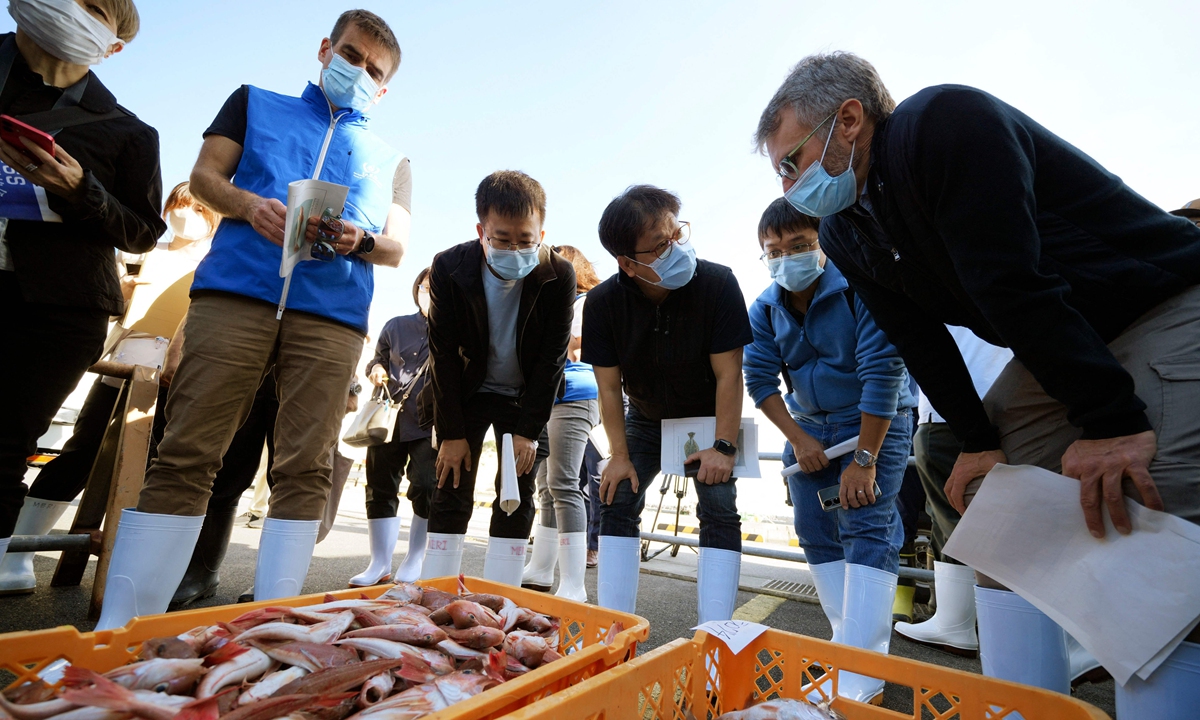
A team of experts from the International Atomic Energy Agency (IAEA) with scientists from China, South Korea and Canada examine baskets of fish to be taken as samples at Hisanohama Port in Iwaki, Japan's Fukushima Prefecture, on October 19, 2023. Photo: VCG
However, since the first batch of dumping, the Japanese government seems to have shifted its cognitive strategy. Turning from actively chattering to falling silent, it began to passively respond to doubts from the outside world, especially from neighboring countries.
Japan seemed to be taking the initiative to divert the international community's attention since it started to release nuclear-contaminated wastewater into the sea. Instead of its previous mass information campaign, the public could only find a few "examining reports" or "statements" that Japanese authorities had released to "prove the safety" of the dumped water.
Yet their credibility and scientific accuracy need to be questioned. One month after the start of the discharge, for instance, Japan's Fisheries Agency stated, on its website, that "no detectable amount of tritium had been found" in fish samples taken from waters near the crippled Fukushima Daiichi nuclear plant, Kyodo News Agency reported on September 25, 2023.
However, the "fish samples," as the Fisheries Agency said on its website, were just two olive flounders. It soon caused controversy on social media at that time, with many people criticizing the Japanese government for fooling the public. "Using only two fish to prove safety [of the discharged water]? Is the Japanese government kidding?" one user said on X. "There are so many radioactive substances, how could Japan only detect tritium?" commented another.
Faced with continued questioning from neighboring countries, Japan hopes to deliberately cool down and downplay the issue, allowing the international community to possibly overlook it, Lü Chao, an expert on the Korean Peninsula at the Liaoning Academy of Social Sciences, told the Global Times.
Lü noted that Japan's previous trick was to use the International Atomic Energy Agency (IAEA) as a shield, touting the one-sided inspection results of the IAEA as "fair" and "authoritative," but this has never been convincing.
"Japan has a dark history of falsifying data in the past, and its detection of nuclear-contaminated wastewater only measures a few elements," Lü warned. "The problem will continue to emerge as time goes on and the amount of wastewater discharged increases."
While trying to downplay the risks of its nuclear-contaminated wastewater dumping, Japan began to hype other forms of pollution to divert public attention. Data suggests that some Japanese media outlets began to frequently report on Per- and Polyfluorinated Substances (PFAS) pollution incidents since late 2023, although PFAS pollution is nothing new in Japan.
PFAS are a group of chemical substances that are feared to be carcinogenic. In March, many Japanese media outlets including the NHK and the Japan Times reported that PFAS had been detected in the groundwater across Tokyo, and in the blood of residents. Intensive media coverage that suggested US military bases led to the PFAS pollution mushroomed in the following months, causing widespread anger among people in Japan.
Japanese media outlets had covered the country's PFAS pollution problem near US military bases in early 2016, and nothing had changed thereafter. The recent push in similar reporting is, therefore, no more than a distraction tactic designed to divert people's attention from nuclear-contaminated wastewater pollution.
Japan has also been maliciously blaming its own nuclear-contaminated wastewater dumping on China. A troublemaker itself, Japan has been portraying itself as a "victim" of China's "aggressive" response to the wastewater discharge, continually fomenting hostile sentiments against China at home.
What's even more serious is the current attempt by some Japanese politicians and media outlets to shift the blame to countries with louder voices of opposition in the issue of nuclear-contaminated wastewater discharge, turning a serious environmental pollution issue into a bilateral issue between China and Japan, or between South Korea and Japan, Lü said. "But such measures, besides casting a shadow over China-Japan relations, are meaningless and doomed to be short-lived."
Deep fear
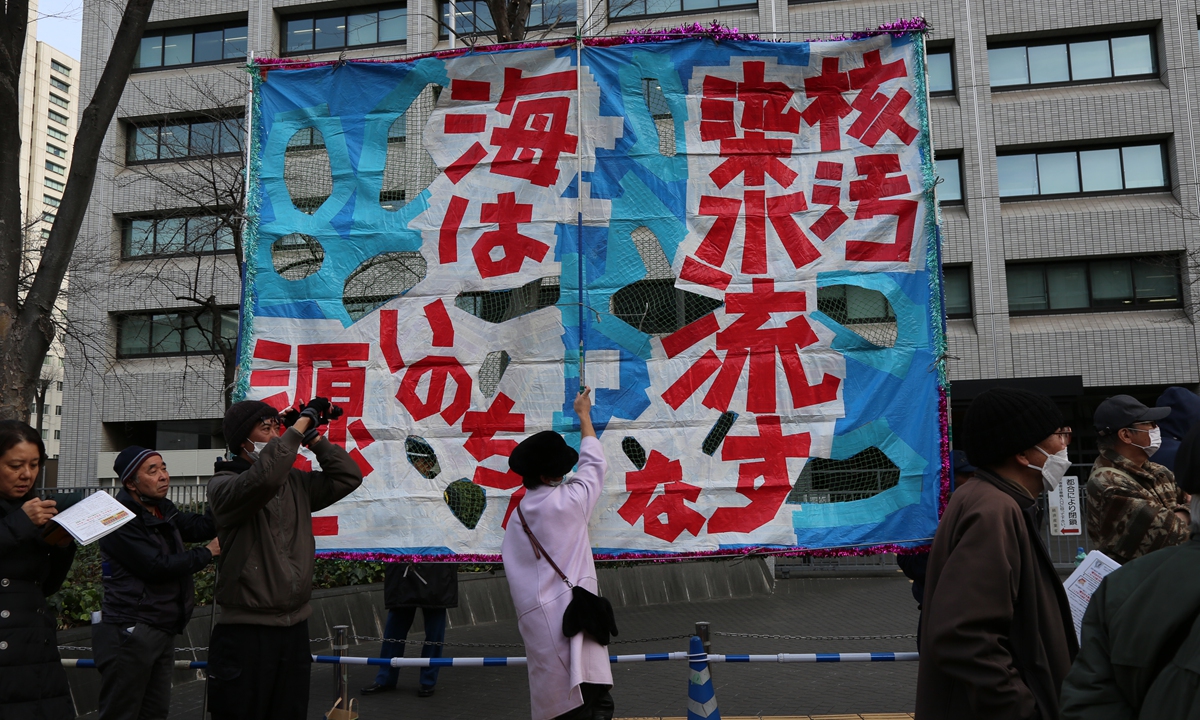
Local people hold a rally against the Japanese government and TEPCO's release of nuclear-contaminated wastewater into the sea in Tokyo, Japan, on March 11, 2024. Photo: VCG
Japan has opened Pandora's box with the continued discharge of radioactive wastewater. A few unusual phenomena have happened in the country since the dumping started, including a large amount of Sappa (or Japanese-scaled sardine) washing up dead at the Nakiri fishing port in December 2023."I've never seen anything like this before," commented a fisherman operating in Nakiri for 25 years, quoted by Japanese media outlet The Mainichi in an article that month. "It makes me feel the marine ecosystem is changing," the fisherman said.
Some linked the massive quantities of dead sardines to Japan's irresponsible wastewater release. Although there has been no solid scientific basis for such an association, it has reflected people's deep fear over the potential great harm that the wastewater dumping may cause to the ecological environment.
Although the mainstream media in Japan has rarely reported on the hidden dangers and concerns caused by the nuclear-contaminated wastewater dumping, probably because of the government or advertising influence, some local residents reached by the Global Times admitted that they are actually "living in great anxiety every day."
Chiyo Oda, the representative of Japanese environmental NGO "Stop polluting the oceans!" said that the organization's protest activities had already begun when the Japanese government suggested the dumping plan at the very beginning. "We took to the streets to protest, invited experts to explain the dangers of dumping, and tried to propose alternative solutions..." recalled Oda. He said they felt deeply surprised and disappointed after learning that the Japanese government had insisted on the dumping plan.
"The government heard our opposing views, but just ignored them," Oda told the Global Times.
The Japanese government may not be good at dealing with nuclear-contaminated wastewater, but it must be very good at waging cognitive warfare to whitewash its poisonous wastewater dumping.
Documents showed that the Japanese Foreign Ministry had increased its 2024 budget specially designed to respond to "disinformation" about the dumping plan to approximately 70 billion yen ($478 million), the NHK reported in August 2023. The 70-billion-yen "PR budget" is allegedly almost 20 times the budget for the nuclear-contaminated wastewater discharge itself.
"How many radioactive substances does nuclear-contaminated wastewater exactly contain? Once being released into the sea, how will the wastewater spread and where will it flow?" asked Oda. "How can the wastewater dumping make people feel at ease if these basic issues are not yet clear?"
Obviously, the Japanese government has not tackled this issue seriously from the very beginning, nor has it seriously responded to all kinds of questions from the outside world, criticized Oda. "Now there is no trust in the government."
Zhang Yuze also contributed to this story
